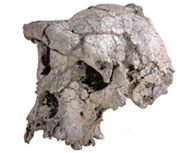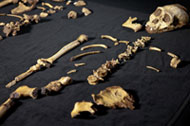How long have we been here?
Genetic and fossil evidence indicates that our family tree may go back 6 or 7 million years in Africa and that our own species’ origin also lies there.

Nicknamed Toumaï, the Sahelanthropus tchadensis skull has both ape-like and human-like features and is between 6 and 7 million years old © MPFT
The origins of humankind on Earth
It is estimated that the first members of the human family (hominins) lived in Africa about 6 or 7 million years ago. They are believed to have been forest-dwelling, perhaps walking upright in the trees or when on the ground.
In 2001, cranial fossils of Sahelanthropus tchadensis dating to this time were uncovered in Chad, central Africa. The fossils show a combination of ape-like and human-like features, although how closely related Sahelanthropus tchadensis is to humans is the subject of debate.
Over millions of years, distinct species and lineages emerged and radiated across Africa. Among them were the earliest members of the genus Homo, to which modern humans belong.

Replicas of the remarkably complete Australopithecus sediba fossil skeletons found in Malapa Cave, South Africa in 2010.
The earliest fossil evidence of these ancient humans dates to between 1.9 and 2.4 million years ago, and comes from East Africa, although a human-like form of the species Australopithecus has recently been described from South Africa. Australopithecus sediba is 1.98 million years old and is the most human-like australopithecine yet discovered, with an increased front brain cavity and small teeth.
The emergence of modern humans
Fossil evidence suggests that modern humans evolved in East Africa around 200,000 years ago, since fossils more than 150,000 years old are known from Ethiopia and Kenya. However, genetic data from recent African populations suggests that other regions may also have been important.
One study compared the DNA of modern hunter-gatherers. The results revealed that Namibian and Khomani Bushmen of southern Africa, Biaka Pygmies of Central Africa and the Sandawe of East Africa have the highest levels of genetic diversity in the world for the DNA studied.
Although genetic studies should be treated with caution when it comes to pinpointing origins, genetic diversity is one indicator of how ancient a people are. In principle the more ancient the population, the more time it has had to build up diversity.
